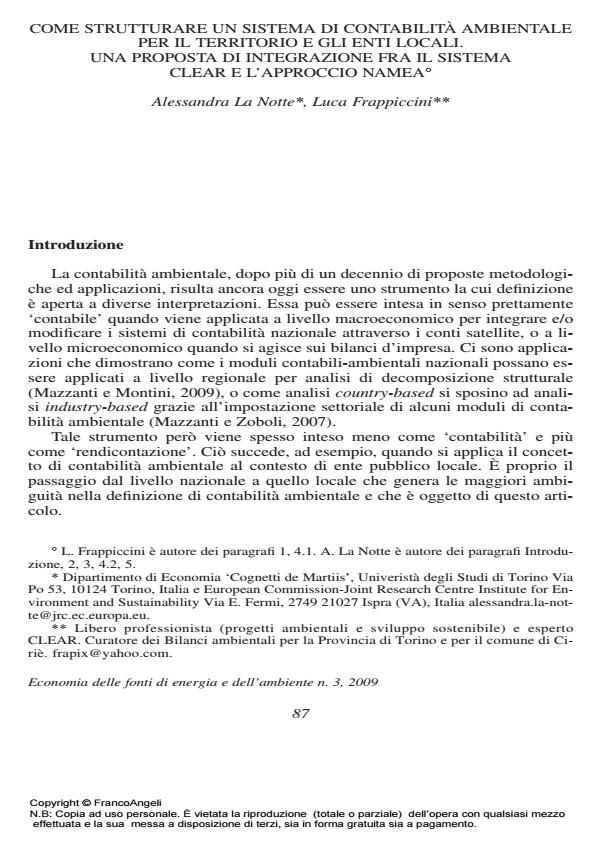Come strutturare un sistema di contabilità ambientale per il territorio e gli enti locali. Una proposta di integrazione fra il sistema CLEAR e l'approccio NAMEA
Journal title ECONOMIA DELLE FONTI DI ENERGIA E DELL’AMBIENTE
Author/s Alessandra La Notte, Luca Frappiccini
Publishing Year 2010 Issue 2009/3
Language Italian Pages 21 P. 87-107 File size 1145 KB
DOI 10.3280/EFE2009-003005
DOI is like a bar code for intellectual property: to have more infomation
click here
Below, you can see the article first page
If you want to buy this article in PDF format, you can do it, following the instructions to buy download credits

FrancoAngeli is member of Publishers International Linking Association, Inc (PILA), a not-for-profit association which run the CrossRef service enabling links to and from online scholarly content.
How to integrate systems of environmental accounts for the sub-national territory and for the local authorities. A proposal for CLEAR and NAMEA in Italy - In the last decades a growing importance is given to environmental accounting even though a clear and universally agreed definition is not provided for this tool. On the one hand national statistical offices and international organizations have been working on integrated environmental and economic accounts (SEEA) that through satellite accounts ‘complete’ the SNA. On the other hand at local levels some initiatives, such as Agenda 21, coordinated by international groups, such as ICLEI, have been testing ways to enable local authorities to keep an environmental accountability. The two systems are very different and refer to different administrative scales. The purpose of this article is to test the feasibility and utility of finding a way to combine them. Currently the accounting modules reported in the SEEA only apply to the macroeconomic scale. These modules could indeed be very useful and interesting if applied to local contexts to target specific issues of interest for local planners. At the same time the environmental accountability introduced by local authorities is sometime missing some common rigorous procedures when organizing the environmental reports and thus this information is not going to assume a proper role and importance. The integration for the two systems become possible if it is made clear the difference between accounting modules and reporting indicators. In this perspective the two systems become complementary and not substitutive. There is in fact the necessity at local level to be flexible in order to take into account the specificity of the territory, but there is also the necessity of keeping the data reliable and consistent over time and among different territories for horizontal comparison. In this paper we proposed an integration procedure among the accounting modules of the SEEA and the indicators used in the physical account part that compose the CLEAR system, very popular in some Italian provinces and municipalities. Specifically we started thinking about the possible indicators calculated from NAMEA-air and NAMEA-waste to be inserted in the physical accountability section of CLEAR for the Province of Torino.
Keywords: Environmental accounting, NAMEA, eco-budget, CLEAR, air emissions, environmental indicators
Jel codes: Q53, Q56, H76
Alessandra La Notte, Luca Frappiccini, Come strutturare un sistema di contabilità ambientale per il territorio e gli enti locali. Una proposta di integrazione fra il sistema CLEAR e l'approccio NAMEA in "ECONOMIA DELLE FONTI DI ENERGIA E DELL’AMBIENTE" 3/2009, pp 87-107, DOI: 10.3280/EFE2009-003005